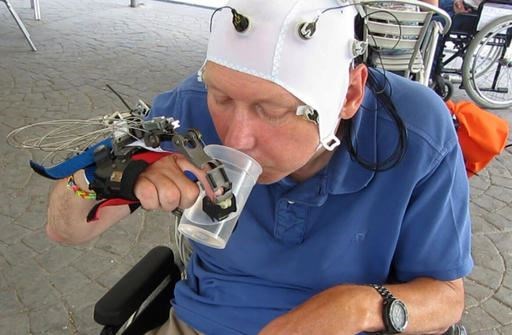 |
| In this undated grab taken from video, a patient uses a robotic hand to drink from a cup, in Badalona, Spain. Scientists have developed a mind-controlled robotic hand that allows people with certain types of spinal injuries to perform everyday tasks such as using a fork or drinking from a cup. (Mario Cortese video via AP) |
BERLIN (AP) — Scientists have developed a mind-controlled robotic hand that allows people with certain types of spinal injuries to perform everyday tasks such as using a fork or drinking from a cup.
The low-cost device was tested in Spain on six people with quadriplegia affecting their ability to grasp or manipulate objects.
By wearing a cap that measures electric brain activity and eye movement the users were able to send signals to a tablet computer that controlled the glove-like device attached to their hand.
Participants in the small-scale study were able to perform daily activities better with the robotic hand than without, according to results published Tuesday in the journal Science Robotics.
The principle of using brain-controlled robotic aids to assist people with quadriplegia isn't new. But many existing systems require implants, which can cause health problems, or use wet gel to transmit signals from the scalp to the electrodes. The gel needs to be washed out of the user's hair afterward, making it impractical in daily life.
"The participants, who had previously expressed difficulty in performing everyday tasks without assistance, rated the system as reliable and practical, and did not indicate any discomfort during or after use," the researchers said.
It took participants just 10 minutes to learn how to use the system before they were able to carry out tasks such as picking up potato chips or signing a document.
According to Surjo R. Soekadar, a neuroscientist at the University Hospital Tuebingen in Germany and lead author of the study, participants represented typical people with high spinal cord injuries, meaning they were able to move their shoulders but not their fingers.
There were some limitations to the system, though. Users had to have sufficient function in their shoulder and arm to reach out with the robotic hand. And mounting the system required another person's help.
Jan Schwab, an expert on spinal cord injury at Berlin's Charite hospital who wasn't involved in the research, called it an interesting pilot study that needs to be followed up with further clinical tests.
"Bigger studies will be very important to find out which patients respond well, less well or not at all," Schwab said.
Soekadar said the system could be brought to market within two years at a cost of between 5,000 and 10,000 euros ($5,370 to $10,740), depending on functionality.
The device could also be used to help re-train the brain of stroke patients undergoing rehabilitation, he said.
Copyright 2016 The Associated Press. All rights reserved.
This material may not be published, broadcast, rewritten or redistributed.
Page created on 12/6/2016 3:35:08 PM
Last edited 12/6/2016 3:35:08 PM

